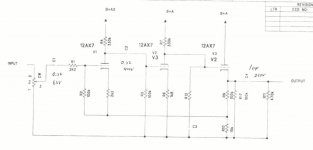Hi i need some help with my audio symphonies plus preamp could anybody show me the correct polarity of the capacitors in the attached circuit, i would like to upgrade them but none of them are marked any information greatly appreciated, Thankyou http://www.diyaudio.com/forums/attachment.php?attachmentid=180045&stc=1&d=1278943115
Attachments
Use non-polarized metal film or foil caps. Keep electrolytics out of the signal path wherever possible.
They probably already are (non-polarized), hence no polarity markings.
They probably already are (non-polarized), hence no polarity markings.
Some film caps have the outer foils marked, and all can be identified using a generator and scope. Generally the recommendation is to orient the non-polar cap so that the outer foil is connected to the lowest impedance point in a given circuit. In low level circuits this provides some additional electro-static shielding, but in general is not too critical. (I do go to the trouble of orienting my caps this way in most all cases, but have not consistently heard the night and day "differences" some have claimed based on orientation.)
Yes true. I was thinking in terms of electrolytics as theyare polarized, since the input cap (0.22@63V) and output cap (1u@250V) could logically be electrolytics.
Film caps are not polerized per se, but as you point out have prefered orientation.
With that in mind, what is the recomendation for handeling the body of metal shell film caps like the K40Y-9? Leave the can floating? Ground it? Tie it and the outer film to the low impedance connection?
The metal can K40Y-9 (etc) is/are easy to measure for outer foil lead, since one can simply measure the capacitance from each lead to case and the higher capacitance lead is the outer foil one.
Film caps are not polerized per se, but as you point out have prefered orientation.
With that in mind, what is the recomendation for handeling the body of metal shell film caps like the K40Y-9? Leave the can floating? Ground it? Tie it and the outer film to the low impedance connection?
The metal can K40Y-9 (etc) is/are easy to measure for outer foil lead, since one can simply measure the capacitance from each lead to case and the higher capacitance lead is the outer foil one.
Thankyou for your replies i have some russian k75-10 caps would these be a good choice and where is the low impedence points in this circuit. Thankyou
- Status
- Not open for further replies.
